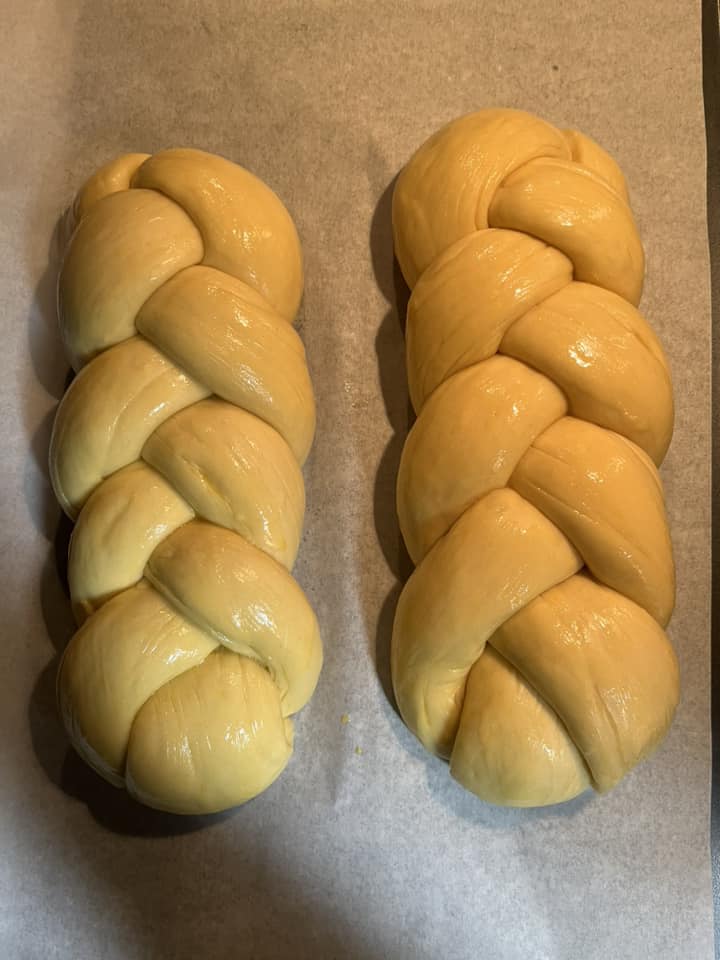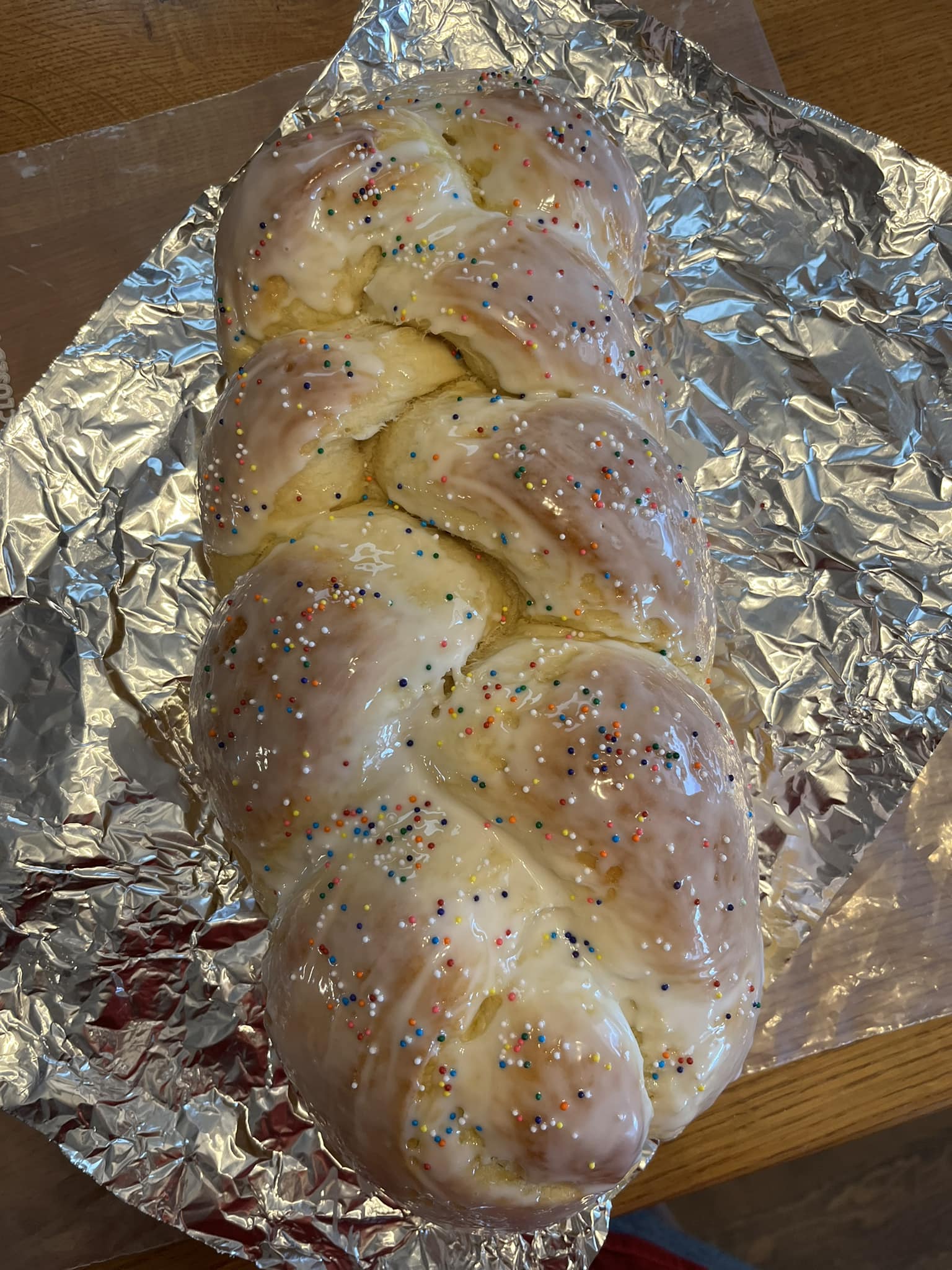Easter Bread
Easter Bread is a soft, lightly sweet braided bread that’s traditionally baked to celebrate spring and renewal. Infused with hints of vanilla and anise, this golden loaf is tender, aromatic, and beautiful on any holiday table.
Whether served with butter at breakfast or alongside coffee during Easter brunch, it’s a celebration in every slice.

Why You’ll Love This Recipe
Perfectly soft and tender: Enriched dough makes it buttery and rich.
Mildly sweet: Great as a standalone treat or paired with spreads.
Beautiful presentation: The braided shape is eye-catching and festive.
Tradition meets taste: A classic family recipe you’ll want to make every spring.
Customizable: Add decorative eggs or colorful sprinkles if desired
Key Ingredients
All-Purpose Flour – The structure of the bread; start with 4½ cups and add more if needed.
Sugar & Milk – Sweetens and softens the dough.
Butter – Enriches the dough for a tender texture.
Eggs – Add richness and color.
Anise & Vanilla – Fragrant flavor boosters for that signature Easter bread aroma.
Active Dry Yeast – Makes the bread rise beautifully.
Easter Bread

Ingredients:
4 1/2 to 5 cups of flour,
2/3 c sugar,
1 c milk,
6 tbsp butter,
1 tsp salt,
3 large eggs,
1 tsp anise,
1 tsp vanilla,
one packet of yeast. ( 2 1/4 tsp).

Instructions:
Warm milk butter and sugar in saucepan.
Set aside to cool.
Get 1/4 c warm water with 1 tbsp sugar and the yeast.
Let bloom for 5 minutes.
In a stand mixer place the flour(start with 4 1/2c), salt eggs, milk mixture and yeast mixture.
Begin mixing with dough hook until dough is shaggy, not too sticky.
Knead for 4 minutes.
Place dough in well oiled bowl and cover with towel.
Raise 1 1/2 hours.
After it’s raised cut dough into to equal pieces.
Work one piece at a time.
Divide into 3 long ropes.
Place on parchment like picture and raise again.
About 1/2 hour.
Bake at 350 for 25 minutes.
I don’t put the decorative egg in my long loaf.
Enjoy!
Tips and Shortcuts
Let milk mixture cool before mixing with yeast to avoid killing the yeast.
Test yeast bloom: If it doesn’t foam after 5–10 minutes, start again with fresh yeast.
Adjust flour as needed: Dough should be soft and slightly tacky but not sticky.
Braiding tip: If your dough ropes shrink, let them rest for 5 minutes before continuing.
Skip the egg on top? Totally fine — it’s decorative, not essential to flavor or texture.
Kitchen Equipment Needed
Stand mixer with dough hook (optional but helpful)
Saucepan (for warming milk mixture)
Mixing bowls
Measuring cups and spoons
Parchment paper
Baking sheet
Kitchen towel or plastic wrap
Sharp knife or dough cutter
Recipe Swaps and Variations
Flavor Twist: Add citrus zest (lemon or orange) for a refreshing zing.
No anise? Use almond extract or more vanilla.
Raisin or fruit bread: Fold in raisins, dried cranberries, or candied citrus peel.
Decorative Eggs: Dye raw eggs and nestle them into the braided dough before the second rise.
Add a glaze: Brush with a simple powdered sugar + milk glaze and top with sprinkles after baking.
How to Store Leftovers
Room Temp: Store in an airtight container or wrap in foil for up to 3 days.
Refrigerate: Optional, but keeps longer (up to 5 days). Warm before serving.
Freezer: Wrap tightly and freeze for up to 2 months. Thaw at room temp or toast slices.
Food and Drink Pairings
Serve With:
Butter, honey, or jam
Whipped ricotta or mascarpone
Fresh berries or citrus compote
Drinks:
Hot coffee or cappuccino
Sweet or floral teas (like chamomile or earl grey)
A glass of chilled Moscato or Prosecco for brunch
Nutrition Information:
Yields: 12 | Serving size: 1 slice
Calories: 250 kcal | Total Fat: 7g | Saturated Fat: 4g | Cholesterol: 60mg | Sodium: 200mg | Total Carbohydrates: 40g | Dietary Fiber: 1g | Sugars: 10g | Protein: 5g
Frequently Asked Questions:
Can I use a different type of flour for this recipe?
Yes, you can experiment with different types of flour, such as whole wheat flour or bread flour, but it may slightly alter the texture and taste of the bread.
Can I substitute the anise with another flavoring?
Certainly! You can replace the anise with other flavorings like almond extract or orange zest for a different flavor profile.
Can I make this bread without a stand mixer?
Yes, you can knead the dough by hand instead of using a stand mixer.
It will require a bit more effort, but the results will still be delicious.
Can I freeze Easter Bread?
Yes, you can freeze Easter Bread.
Allow it to cool completely, then wrap it tightly in plastic wrap and foil before placing it in an airtight container or freezer bag.
Thaw at room temperature when ready to enjoy.
Why is the bread cut into three long ropes before baking?
Dividing the dough into three ropes and braiding them creates the classic braided shape of Easter Bread.
It’s a traditional way of shaping this type of bread and adds to its festive appearance.
Can I use bread flour instead of all-purpose flour for this recipe?
Yes, you can substitute bread flour for all-purpose flour, but it may result in a slightly different texture.
Bread flour has higher protein content, which can lead to a chewier bread.
What can I use if I don’t have anise?
If you don’t have anise, you can replace it with other flavorings like almond extract, cardamom, or citrus zest to add a different flavor dimension to the bread.
Can I use instant yeast instead of active dry yeast?
Yes, you can use instant yeast instead of active dry yeast.
However, you may need to adjust the amount slightly as instant yeast is more potent.
Use about 25% less instant yeast than active dry yeast.
Can I make this bread without a stand mixer?
Yes, you can knead the dough by hand instead of using a stand mixer.
It will require a bit more effort, but the results will still be delicious.
Why is the dough left to rise for 1 1/2 hours?
Allowing the dough to rise for 1 1/2 hours allows the yeast to ferment and leaven the dough, resulting in a lighter and fluffier texture.
What is the purpose of dividing the dough into three long ropes?
Dividing the dough into three ropes and braiding them creates the classic braided shape of Easter Bread.
It’s a traditional way of shaping this type of bread and adds to its festive appearance.
Can I add nuts or dried fruit to the dough?
Yes, you can customize the bread by adding nuts, dried fruit, or even chocolate chips to the dough for added texture and flavor.
How should I store leftover Easter Bread?
Store leftover Easter Bread in an airtight container or resealable bag at room temperature for up to 3 days.
You can also freeze it for longer storage.
Can I omit the sugar or reduce the amount for a less sweet bread?
Yes, you can adjust the amount of sugar to your taste preferences.
However, keep in mind that sugar not only adds sweetness but also helps with yeast fermentation and browning of the crust.
What can I serve Easter Bread with?
Easter Bread is delicious on its own or served with butter, jam, or honey. It also pairs well with savory dishes like soups or stews.